Welcoming Every Body: Creating Inclusive Spaces in GYROTONIC® Studios
Tips for Trainers // September 04, 2025
Introduction
When we talk about movement, wellness, and healing, we often forget to ask: Who gets to be included? At the 2025 GYROTONIC® Rehabilitation Conference in Washington, DC, Kate McDermott shared her experience as a physical therapist, educator, and Gyrotonic Trainer working with clients who have neurological conditions and physical disabilities. What she realized in preparing for that talk was deeper than techniques or equipment: real inclusion begins long before someone walks—or wheels—through your studio door.
This article offers five practical, thoughtful ways to open your space, your mindset, and your practice to people of all abilities and every body. Some of these ideas may feel like common sense, but they’re worth a second look—you might discover a fresh perspective or a small shift that makes a big difference.
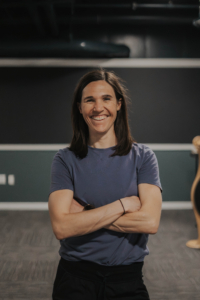
Kate McDermott, DPT, PT, GYROTONIC® Trainer
By Dr. Kate McDermott, PT, DPT & Gyrotonic Trainer
Back in April 2025, I had the honor to speak about working with clients with neurological conditions at the GYROTONIC® Rehabilitation Conference in Washington, DC. There is a lot to know about how to best modify exercises for people with neurological diagnoses. All this knowledge is valuable and complex. I spend months with Doctor of Physical Therapist students teaching them these skills. As I worked to condense the extensive information I wanted to teach at the conference into the 3-hour time slot I was given, I repeatedly paused asking myself questions such as:
“How many trainers actually see clients with neurological conditions and physical disabilities on a regular basis?”
“Are studios even set up for this?”
“How many Gyrotonic trainers would truly feel comfortable taking on a client in a wheelchair?”
I realized that if we aren’t seeing people with neurological conditions or individuals with disabilities in our studios, none of this technical knowledge I want to share even matters. Here are 5 tips to prepare yourself to start working with clients with neurological impairments and physical disabilities.
1. Creating an inviting and accessible space:
Imagine showing up for a GYROTONIC® session at a new studio and the door is locked. You can see everyone inside having a great time. Everyone is smiling through the window at you, and nobody is opening the door. You call the front desk and ask them to come unlock the door. They tell you that unlocking that door would be too much of a financial, logistical or administrative burden for their business. That is what it is like for people with disabilities when we refuse to address their accessibility needs. If people in wheelchairs can’t physically get into your studio, I would urge you to consider what kind of message is that sending?
Working as an outpatient Physical Therapist in a neurological setting for many years, I would see patients just a couple days after they were discharged home from the hospital after sustaining life changing injuries or illnesses. They were often navigating the world in a wheelchair or with an assistive device for the first time. At least once a week, I would hold space for a patient in tears telling me about their struggles and frustrations navigating in their communities. These people frequently told me about feeling unwelcome and left out in a world that is set up for “able bodied” people. These moments would break my heart. As a PT, my job is to help people achieve their physical goals and improve their quality of life. I can teach a person how to ascend a curb in their manual wheelchair but, I can’t magically widen the doorway to their favorite boutique coffee shop. I genuinely believe that people with disabilities have a lot to teach us. When we set up our communities to include people with disabilities, we all benefit from their unique insights and perspectives.
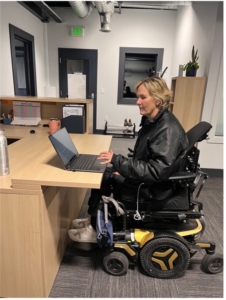
Image provided by Kate McDermott
Lack of accessibility in public spaces is a huge problem, especially in large cities. How can we change this? Start with your studio and move outwards. Here in the United States, we have the Americans with Disabilities Act. The ADA outlines in specific detailed requirements for buildings and facilities from doorway widths to ramp angles. The ADA website has a comprehensive checklist you can start with for your business. If your clients are telling you that the sidewalks outside of your studio are in disrepair, consider whether it would be passable in a wheelchair. If it isn’t your problem to fix, it could still be a problem for your client. A little bit of advocacy can go a long way.
Lastly, Is the outward appearance of your business welcoming to people with disabilities? It is possible that some people might not even call your studio to inquire because they see the photos on your website of a tightly packed space with narrow doors. Here are some things to consider:
- Do you mention your handicapped parking or other accessibility concerns on your contact page?
- Are there photos of clients with physical disabilities on your website?
- Does your intake form include a place for people to request accommodations?
- Are your front desk staff comfortable answering questions about accessibility and accommodations?
2. Communication:
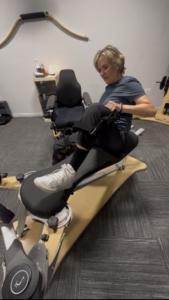
Image provided by Kate McDermott.
Most people with physical disabilities can quickly identify your comfort level working with them just by the way you approach them and talk to them. For many reasons (including the lack of accessibility), people with disabilities are underrepresented in the workplace and the community at large. A lot of people don’t get to interact with these folks on a regular basis. If you don’t have exposure to something, it makes sense that you might not know how to do it very well. If that is you, here are some simple tips:
- Talk directly to your client and look at them. If they are with a caregiver, avoid directing questions to the caregiver. If you are going to have a more in-depth extended conversation or discuss about a sensitive topic, sit down or move to eye level with them.
- The first thing out of your mouth should not be a comment about their disability or assistive device. A simple “How is your day going?” can go a long way. People with disabilities desire to treated like regular people.
- Telling someone with a disability that they are “inspiring” for doing everyday things like getting out of bed in the morning isn’t a compliment. In general, people with disabilities resent being your source of inspiration. It might be more effective to compliment them on improvements you have noticed within their session or between sessions. Compliment them on their work ethic or dedication, things that you would say to any client.
- Jokes such as “How fast does that thing go?” about a wheelchair are not unique. People with disabilities hear these comments and jokes all day long. They are clear signs that you aren’t comfortable with their disability.
- “Disabled” isn’t a swear word or an insult. Terms like “Handicapable” or “Differently Abled” are not necessary. Most people with who have had disabilities for over a couple years generally don’t have a problem identified as “disabled.”
- Ask yourself if your questions are necessary. As their Gyrotonic trainer, it might be necessary to know about the mechanism of their injury or details or their diagnosis. It’s nice to first inquire whether they mind sharing it with you. Many people have trauma associated with their injury or illness, asking them to recall it can be triggering. If it’s a stranger on the street with a disability, it’s generally inappropriate to ask them their personal medical information.
- Don’t be afraid to shake their hands or hug them when it is appropriate. I have heard many people with disabilities express that they miss the normal human physical touch. If you aren’t sure about their hand function, go for the fist bump. If you are uncertain about their right-hand function, confidently reach for their left hand.
- Do not push someone’s wheelchair for them or move the wheelchair away from them without their consent. Do not sit in someone’s wheelchair without their consent. Assistive mobility devices are very much a part of a person’s body and independence. It can feel very vulnerable for someone to have their wheelchair taken away from them without them in it. If I need to move a wheelchair or assistive device, I always ask first. Then, I tell them exactly where I am relocating it to.
- Allow them to try. Having the patience not to step in and help right away allows them to practice their independence. What you might see as a struggle could just be the way that they have adapted to do things independently. Allow them that independence. If you aren’t sure, asking “Let me know if and when you want me to step in and help” can be a good approach.
If you have worked with one client with a neurological diagnosis, now you know that one person with that diagnosis. Every person with disability is a unique human being with unique experiences and perspectives. Get to know them as a person as you would any other client. If talking to a person in a wheelchair makes you uncomfortable, the best way to change that is to go out and make some friends who use wheelchairs. Follow people on social media who have disabilities. Be a student and learn about “ableism.”
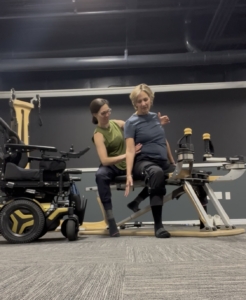
Image provided by Kate McDermott
3. Prepare & Adapt:
There are props and accessories that you can purchase for your studio that will show someone with a disability that you are prepared for them and that they are welcome in your space.
- A grip assist strap. You might not use it for months but, when that client with hemiplegia comes in post-stroke and can’t grip the handle on the handle unit, you will be ready. You can quickly strap them in without fumbling around.
- A larger table to transfer onto to do hamstring series in case the bench is too narrow.
- A gait belt to help support a client while transferring.
Let them teach you how to help them. Most of the people showing up to your studios will know their bodies and how they like to do things. I usually ask, “Tell me how you like to transfer.” Then I show them what I am proposing such as “I want you to sit on the bench with your legs like this. “Do you think that is possible? If not, we can adapt.” Once we decide on the best setup together, I ask “Where and when do you want me to step in and help?” Over time as you get to know your client better, you will need less of this dialogue.
When moving between equipment, give the client some options on how to get there. Move objects out of the pathway. If you are going to need to support the patient’s limbs or help them balance when they arrive at the new piece of equipment, have the props available in that location ahead of time. Utilize family members, aides, front desk staff or anyone willing to help if needed.
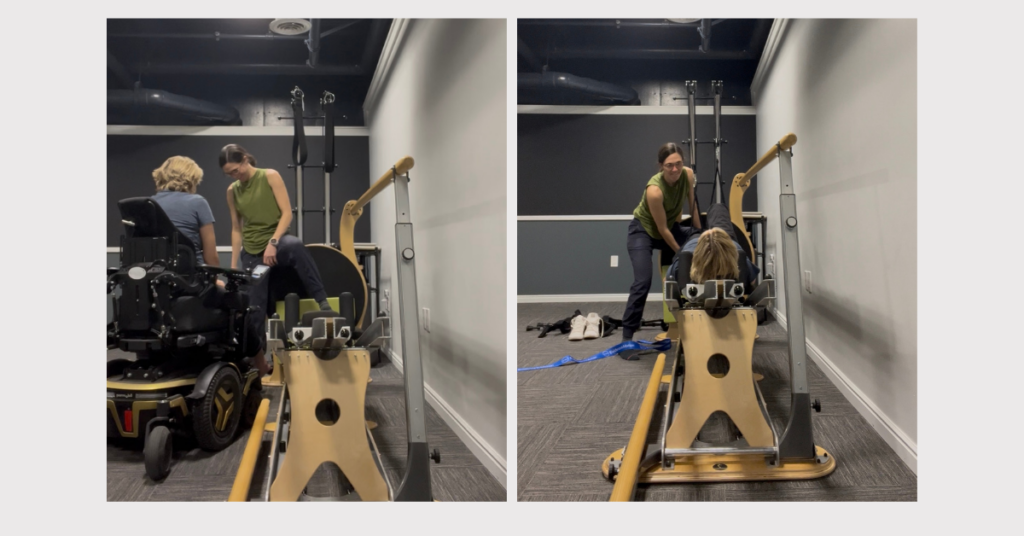
Kate McDermott works with a client
4. Know what you know:
Approaching a client with severe neurological disability can be overwhelming. For example, that person with C3 complete quadriplegia or the person with severe spastic cerebral palsy who is nonverbal and dependent in a wheelchair. Sometimes trainers ask me, “Where do I start with them if they can’t even transfer to the equipment?” The answer is to start from their chairs. The body in front of you might look drastically different than the rest of your clients but, the movement principles are the same. Start with the breath. Start with what they can do and build from there. Something as simple as nodding the head is a spinal motion. Nodding the head is flexion and extension of the cervical spine. It is an arch and curl. Moving the eyes and breathing with intention can be groundbreaking for someone.
Focus on the person in front of you and continue build on what they can do. You are going on a journey together, be patient with the process.
5. Be open to what you don’t know:
When I see a client or patient with a disability for their first session, I spend a lot of time talking and getting to know them. When I finish that, I tell them about myself. For example:
“I am a Physical Therapist with 12 years of experience. I have worked with a lot of people like you and know a lot about how to treat (insert condition here). I haven’t worked with you though. You live in your body and know it better than anyone else. I want to give you permission to teach me as well. Please speak up if there is anything I can do better whether it is how I am handling your legs or if you are worried that sitting on the bench might create a pressure sore.”
If it is the first person I have ever worked with who had a certain condition, I would be honest about that. That honesty is an opportunity to build rapport and trust. It might go something like this:
“I have been teaching the GYROTONIC® method for a very long time and have worked with all different kinds of people. I want to be honest that I have never had a person with (insert condition here) before. I am very happy that you are here, and I am committed to learning as much as I can about your condition.”
Once you identify what you need to learn to more effectively work with your client, there are many ways to acquire that knowledge. Ask to observe that client in their physical therapy visits. If you don’t feel comfortable guarding someone while walking across the studio, don’t do that with your client until you have a comfort level with it. Be honest about what you know, what your client needs and go from there.
Welcoming Every Body
All of this is food for thought. None of us are perfect. I will admit that I have unintentionally said some silly things to patients with disabilities over the years. There are plenty of ways that my studio could be more accessible. We could all do better. I hope that reading this inspired you to look inward and outward. I hope that after reading this you might consider how you or your studio can improve for the benefit of your current or future clients with disabilities. This is not only about setting ourselves and our studios up to allow people with disabilities to access the GYROTONIC method. It is about showing these clients that they are valued, respected and that they truly belong in our spaces.
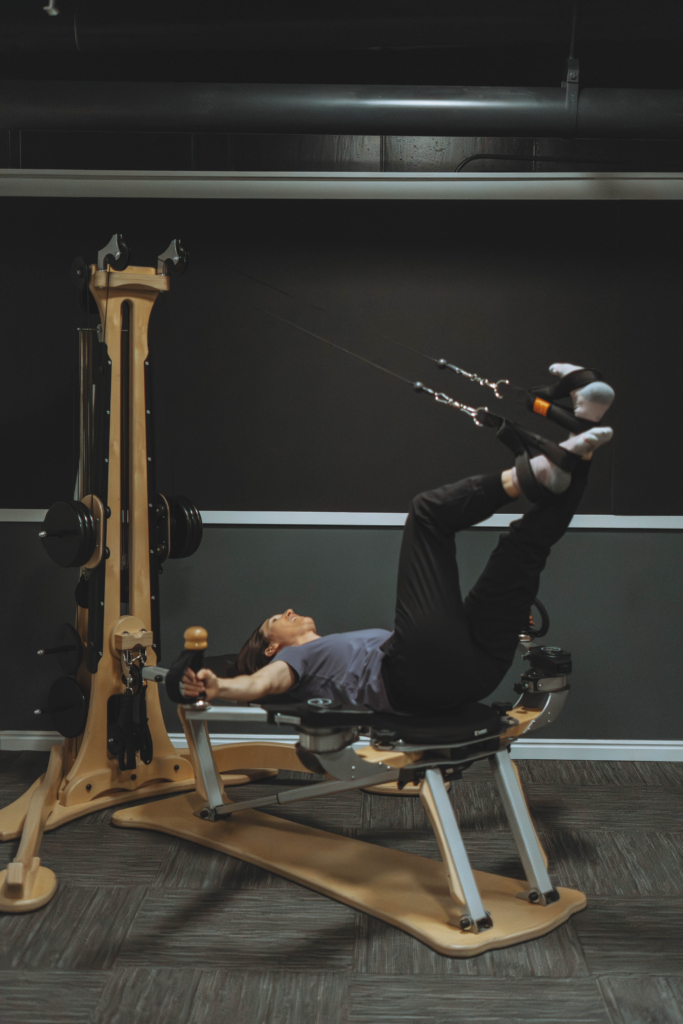
Kate McDermott on the Gyrotonic Ultima Reveal Pulley Tower
__________________________________________________
If you would like to learn more about Kate’s studio and offerings, visit Inside Edge Physical Therapy & Movement or contact her for more information.
Want to read more? Take a look at these other inspiring stories from our community:
Teaching the GYROTONIC® Method From a Wheelchair
Training and Teaching with Physical Limitations
Finding Possibilities: Teacher Training for the GYROKINESIS® Method in a Wheelchair
